Josh McDowell's Blog, page 33
July 31, 2018
Relativism: Does It Contain Any Truth?
 Does our personal version of “truth” (relativism) trump God’s objective truth?
Does our personal version of “truth” (relativism) trump God’s objective truth?In our current “Truth is what I say it is” culture, we have to ask if the issue of truth really matters. I mean, we all seem to be doing okay in life with our own version of truth, right?
Actually, no. When a society embraces a slippery slope of “truth,” its foundation turns from firm to shaky. A culture’s attack on truth ultimately affects the culture itself. People may hate the supposed strictness of God’s objective truth, but we have only to look around to see that societal morals that were once black and white have muddied to endless shades of gray. To ignore the negative side effects of this is to certainly put one’s head in the sand.
Like Neo in the Sci-Fi thriller The Matrix, our human nature prompts us to choose the pill that gains us a truthful reality. We’re hard-wired to seek out truth. And we instinctively know when we’re deviating from God’s objective truth, even if we ignore it or try to erase it as the standard to which we should be living.
Let’s look at three truths about truth, and why the assertion that “truth is relative” is completely wrong. Real, objective truth matters. In every area of our lives.
~ The Truths About Truth ~
Truth Is Logical
Logic presupposes that truth is real, and that “first principles” are truths that cannot be denied, because they are self-evident. Logic applied to reality is a key example of a first principle. All logic can be reduced to a single axiom: the law of noncontradiction. This law says that no two opposite statements can both be true at the same time in the same sense. Logic must apply to reality. And because of that, we can use logic to test truth claims about reality.
Truth Is Objective
Though we can make subjective claims based on personal preferences — for example, “Chocolate ice cream is the best flavor in the world!” — this makes the claims only “true” for us and anyone who agrees with us. The statement is only true because we believe it to be true. These statements of “truth” can easily change, based on our current preferences.
But objective truths are true no matter what we believe about them. They do not change because of our thoughts of whims. They are mind-independent and depend on the object itself.
“Objective truths, as opposed to subjective preferences, are based on the external world,” states apologist Sean McDowell. “They are related to the world independently of how we think or feel. For example, the sentences ‘1+2=3’ and ‘George Washington was the first president of the United States,’ and ‘Sacramento is the capital of California’ are all objective truths, that is, they are accurate statements even if we don’t believe them.”
Truth Is NOT Relative
We are free to have all the subjective preferences we want — from religion to politics to morality — but objective truth is not swayed by our personal views or even the collective view of society. So those who argue that all truth is subjective are espousing a form of relativism.
Relativism creeps into our vocabulary in statements like, “Well, that’s true for you, but not for me.” Unfortunately for those who champion relativism, the concept fails for two main reasons, which I outline below.
~ The Failure of Relativism ~
The first failure of relativism is that it is self-defeating. The second is that relativism leads to absurd logical outcomes.
To be consistent, the relativist must say, “Nothing is objectively true — including my own position. So you’re free to accept my view or reject it.” But here’s the reality: when a relativist asserts, “Everything is relative,” he expects his listeners to embrace HIS view of reality. And he expects his statement to pertain to all statements EXCEPT his own.
Norman Geisler puts it this way: “The only way the relativist can avoid the painful dilemma of relativism is to admit that there are at least some absolute truths. As noted, most relativists believe that relativism is absolutely true and that everyone should be a relativist. Therein lies the self-destructive nature of relativism. The relativist stands on the pinnacle of an absolute truth and wants to relativize everything else.”
The point not to miss: One can’t hold to relativism and insist that others do so as well. It’s a contradiction.
Relativism is a popular idea because, on the surface, it sounds accepting, inclusive, and easy-going. But it is only when we think through its implications, and apply them rigorously to life, do we see the pitfalls of being so accommodating.
As philosopher Paul Copan notes:
“Truth’s elusiveness in some areas of life is a major reason people believe something can be ‘true for you, but not for me.’ Looking around, the relativist comes to one firm conclusion: Too many people genuinely disagree about too many things for use to know truth. Significant — almost irreconcilable — differences in vital dimensions like religion, morality, politics, and philosophy can make it seem rash or even arrogant to say one perspective is true or mostly true and others are totally or partially wrong. Supposedly, then, the sensible conclusion to draw is that relativism must be true.”
In actuality, however, the only part of relativism that is true is that our perspectives do change the way we view events.
So while social and personal relationships do tend to define what people take to be true and false, these influences do NOT determine what is true or false with respect to objective reality. We may not see the truth correctly, but this does not diminish that the actual reality of truth exists.
Skeptics can cry, “God doesn’t exist!”, and personally believe it to be true. But God’s existence, in no way, is determined by our view of it.
~ Conclusion ~
As philosopher and author Steward E. Kelly says, an attempt to deny that truth exists is hopeless. “If there were, hypothetically speaking,” he adds, “no such thing as truth, then would it be true that there is no truth?” Apologist Ravi Zacharias puts a finer point on this when he says, “Truth by definition is exclusive.”
If truth were all-inclusive, he adds, “nothing would be false. And if nothing were false, what would be the meaning of true? Moreover, if nothing were false, would it be true to say that everything is false? It quickly becomes evident that the denial of truth as an absolute either ends up denying itself or else in effect not making any truthful assertion about truth.”
When we choose to view “truth” as subjective, we make it impossible to argue for any sort of binding morality or ethics. Bottom line: when real, objective truth dies, ethics die, too. Relativism undermines even the value of humanity.
Apologist Gregory Koukl puts it this way:
“If truth can’t be known, then the concept of moral truth becomes incoherent. Ethics become relative, right and wrong matters of individual opinion. This may seem a moral liberty, but it ultimately rings hollow. “The death of truth in our society has created a moral decay in which ‘every debate ends with a barroom question, ‘Says, who?’ When we abandon the idea that one set of laws applies to every human being, all that remains is subjective, personal opinion.”
But the Bible draws a clear contrast between truth and error; the Bible does not present truth as a cultural creation. When Jesus drove a stake into the ground by claiming, “I am the way, the truth, and the life,” He did so to give us a clear standard of truth to follow.
Imagine if God continually changed His mind, and kept us guessing as to His nature and what he wants/expects from us. Sounds like the petulant Greek gods, if you ask me. Fortunately, God is NOT like that. His loving character never changes. And neither do the truths He has chosen to share with us via His Word.
From what influence are you determining “truth”? From the world, or from God’s Word? Because only the latter offers the real thing.

This blog post highlights Josh and Sean McDowell’s recently revised apologetics classic, Evidence That Demands a Verdict. We are certain this fully updated and expanded resource will be an effective evangelism tool for you, and strengthen your faith by answering the toughest questions tossed to you by skeptics. Know what you know, because it’s true. But share this truth with LOVE!
If you’d like to start from the first blog post in this series, click here: Apologetics: Apologizing for Believing in God?.
The post Relativism: Does It Contain Any Truth? appeared first on Josh.org.
July 28, 2018
What are the Best Questions for Spiritual Conversation? Quick VIDEO
Original post by Sean McDowell here. Used with permission.
Sean McDowell, Ph.D. is a professor of Christian Apologetics at Biola University, best-selling author, popular speaker, part-time high school teacher, and the Resident Scholar for Summit Ministries, California. Follow him on Twitter: @sean_mcdowell and his blog: seanmcdowell.org.
The post What are the Best Questions for Spiritual Conversation? Quick VIDEO appeared first on Josh.org.
July 27, 2018
Book Review: The End of Faith
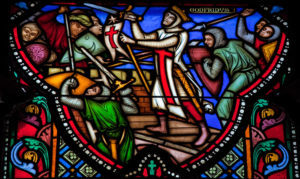
A few years ago, I worked through The God Delusion by Richard Dawkins, a popular atheist thinker who argued against a theistic worldview. I chose to read the book because I believe that it is important for Christians (and anyone, for that matter) to engage with viewpoints other than our own. Although I did not find the main thrust of his arguments very convincing, I still wrote about the experience because I found it to be quite formative to my understanding of atheism.
Standing tall next to Richard Dawkins in the world of “New Atheism” is another man by the name of Sam Harris. I had the chance to read his popular title The End of Faith, where he argues that religion, particularly Western religion, is foolish to believe, harmful to society, and needs to end. My purpose in writing a review of this book is not to bash Harris or pretend like I know everything. But I hope to offer some constructive dialogue in contribution to the very important subject of religion in our world. I’m using the print edition from 2005.
Blind Faith
One thing I noticed right away with Harris’s evaluation of faith is that it is blind, without reason, and fundamentally opposed to rationality.
This is a common objection to theism which atheists often point out, but I was a little surprised to find Harris talking as though the vast majority of all Western religious people believe this way. “On this subject,” writes Harris, “liberals and conservatives have reached a rare consensus: religious beliefs are simply beyond the scope of rational discourse.” (Page 13). And further, “How is it that, in this one area of our lives, we have convinced ourselves that our beliefs about the world can float entirely free of reason and evidence?” (Page 17).
Clearly, Harris has a problem with blind faith.
So do I.
And so does almost any thoughtful Christian who recognizes the use/endorsement of persuasive rationality by Paul (Acts 18:28), Peter (1 Peter 3:15), John (1 John 1:1-3), and Jesus (Matthew 22:23-32).
To be fair, Harris does recognize that some religious people might try to use rationality to come to conclusions about the existence of God. He says “This is probably a conclusion that many religious believers will want to resist” (Page 63).
I can’t help but sense that Harris is also resisting this conclusion. As an atheist, he doesn’t seek to address it, at least not so much in this one book I read. In doing so he misses a great number of us. I recognize that rational faith is not his focus (see Page 65), but if he’s going to address mainstream Christianity, I think it ought to be.
Trivial Squabble
Another common thread in Harris’s thinking is that religious people debate about things which seem so trivial to him.
In order to make his point, he asks us to imagine if humanity lost all of its knowledge and begun the work to reclaim it all over again. Then on page 23, he asks “When in this process of reclaiming our humanity will it be important to know that Jesus was born a virgin? Or that he resurrected?” What about the knowledge that Jesus’ miraculous birth shows that he is God? What about the knowledge that the resurrection of Jesus was a victory over death itself rendering salvation to everyone who believes in his name?
Instead, Harris thinks that our message is as trivial as “rival interpretations of Star Was or Windows 98” (Page 36).
The difference is that no interpretation of Han Solo claims that he died for your sins! If the message of Jesus is true, wouldn’t it be important information worth caring about?
The Seeds of Chaos
A large portion of The End of Faith is dedicated to showing that religion, particularly Christianity and Islam, has created great evil.
One prime example he gives for Christianity is that they are to blame for the Jews who were killed at the holocaust. He doesn’t claim that Hitler was a devout Christian who was simply living from his religious convictions (Harris doesn’t go there, although some have tried). Rather, he argues that it was the Christian hatred toward Jews which influenced the German culture at large, setting the stage for Hitler’s hate speech to gain momentum (See page 100-101).
This is not a fair assessment. Many influences poured into the making of Hitler’s tyranny, influences which Harris has chosen to ignore. Listen to the words of Ravi Zacharias in response to this argument:
Has Harris read about Hitler’s own spiritual journey? Has he read anything about Hitler’s dabbling in the occult? Is he aware that Hitler personally presented the writing of Nietzsche to Stalin and Mussolini?
Is he ignoring the fact that others who were not Jewish were also slaughtered by Hitler?… Does he recall Hitler’s words inscribed over one of the gas ovens in Auschwitz – “I want to raise a generation of young people devoid of a conscience, imperious, relentless and cruel”?
Does he know that Hitler’s point was that the destruction of the weak is a good thing for the survival of the strong and that “nature intended it that way,” as is taught by atheistic evolution’s tenet of natural selection?… None of these signs of the Holocaust point back to Christianity… (Zacharias, The End of Reason, 51-52.)
From reading The End of Faith, you get the sense that the deck has been stacked against religion. When something is unthinkably evil, only faith could have done it. (see Page 31).
The non-religious evils like the reign of Stalin is “little more than a political religion” (Page 79). Even religious “moderates” are dangerous to society for their inability to address extremism (See Pages 14-15, 20). And although Harris agrees that “there are millions of people whose faith moves them to perform extraordinary acts of self-sacrifice for the benefit if others,” he quickly reminds us that “there are far better reasons for self-sacrifice than those that religion provides… By contrast, the most monstrous crimes against humanity have invariably been inspired by unjustified belief.” (Pages 78-79).
Why aren’t these swords of criticism wielded against Harris’s own beliefs? “How conveniently the atheist plays word games,” writes Zacharias, “When it is Stalin or Pol Pot who does the slaughtering, it is because they are deranged or irrational ideologues; their atheism has nothing to do with their actions. But when a Holocaust is engendered by an ideologue, it is the culmination of four hundred years of Christian intolerance for the Jew.” (Zacharias, 52.)
I don’t wish to defend actions done by religious people which actually were evil. There are plenty of examples, and it is horrendous and embarrassing.
But for Christianity, the murder of Muslims in the crusades or the burning of witches and heretics in the medieval times (See chapter 3) are in violation of what it means to be a follower of Christ!
They go directly against the sacredness of human life and the mission of Jesus that all may be led to repentance for the forgiveness of their sins!
Evil may attach itself to Christianity, and even find cover under the disguise of “religious piety,” but it will never belong there. You cannot blame a system of belief based off its malpractice.
The Science of Good and Evil
Throughout the entire book, Harris evaluates the history of religion as he makes moral judgments. This is thin ice for an atheist because a worldview without God does not offer a foundation for making universal claims to good and evil.
For a Christian, evil is a violation of the sacred purpose for which God intended in something, and it goes against the very nature of who God is. But if everything is merely atoms and chemicals, and if life is only a product of evolutionary processes, what makes something good or evil? Why is killing worse than giving? Why is love better than hatred?
If Harris is to stand on his argument, he absolutely needs to provide a basis by which he can make judgments on the actions of other people. How does he do it?
The question is addressed in chapter 6, The Science of Good and Evil. The proposed solution is offered right at the beginning of the chapter: “A rational approach to ethics becomes possible once we realize that questions of right and wrong are really questions about the happiness and suffering of sentient creatures. If we are in a position to affect the happiness or suffering of others, we have ethical responsibilities toward them” (Pages 171-172).
A response like this doesn’t get at the problem. Why should we equate morality with happiness? Why are we responsible to affect the happiness and suffering of someone else? What if a rapist experiences more happiness raping someone than the sadness in the one being raped?
Harris never really addresses these deeper issues. Instead, he goes on to talk about how we don’t need religion as motivation for doing good… but how did we get on the topic of moral “motivation?” The problem with atheism is not that they have no motivation to do good. The problem is that goodness is objectively real only in a theistic worldview, and they are trying to wield it as against a theistic worldview.
Science cannot answer questions of morality. It will never get us any closer. That’s not what science does for us.
We might learn how to measure chemicals of happiness and sadness in the brain, but science will never tell us why one chemical in the brain matters more than another chemical.
If atheists are to defend themselves against this moral dilemma presented by theists like myself, they must not get sidetracked with conversations of moral motivation or unsubstantiated ethical theories.
Final Thoughts
For a time, I was somewhat of an “athiest-phobe,” thinking that all atheists were just angry, disturbed souls with the power of Hell to drag people under.
This is far from the truth.
Just like me, Sam Harris is concerned about people and he wants what’s best for them.
He writes out of great concern for the harm that religion has done in our history, and with the conviction that society would be far better off without it. I wholeheartedly believe that his concerns are misplaced, but that doesn’t make him any more distant from God’s love for every lost soul.
No doubt, Harris has been beaten over the head by many Christians who forgot that our battle is not against flesh and blood (See Eph. 6:12).
But if we live with with the love of tangible Christ and the knowledge of the truthfulness of God’s Word, books like these would be much harder to write and much harder to sell.
If you are reading this post, please pray for Sam Harris and all those who have never tasted the beauty and truth of God’s amazing love.
The post Book Review: The End of Faith appeared first on Josh.org.
July 24, 2018
Do Alleged Contradictions Skew Bible Truth?
 Bible scholars have a proven track record of resolving contradictions to harmonize the Bible.
Bible scholars have a proven track record of resolving contradictions to harmonize the Bible.In this blog post we explore the claim by skeptics that the Bible contradicts itself.
Are there differences among parts of the Bible? Yes. But are they contradictions? No. And we assert this because of two reasons: 1) The Bible is the inerrant Word of God, and 2) Alleged contradictions have, too many times, been proven to not be contradictions as new, relevant discoveries come to light.
The Bible, as inspired by God and recorded by men, is a book of truth. Sometimes we just can’t see the truth because our view is too narrow. It’s like our looking at a scene through the viewfinder of our camera. We can only capture what is within the borders of the shot frame. Just because the camera doesn’t capture the rest of the scene, doesn’t mean it’s not there. Too, we must remember that each writer of Scripture brought his own personal/cultural perspective.
The Bible is composed of 66 smaller books written by a variety of authors, at different times, with different styles, and in different genres. The poetry of Psalms, for instance, should be read differently than the historical narrative of Joshua, the laws in Leviticus, individual Proverbs, or the Gospels. We recognize that God has chosen to reveal Himself through a rich diversity of genres. Each writer communicated what God led him to write, but did so in his own way. That’s not a surprise to God!
Yet one way that Satan leads people away from God is by championing the notion that the Bible can’t be trusted — and, thus, neither can God. This sounds logical, IF the first assumption is correct. But it’s not. Skeptics are free to make whatever claims they like, just as we are free to disregard them. Not because we’re sticking our heads in the sand, but because of God’s track record of being faithful.
Let’s define the term “contradiction,” and look at just five mistakes critics commonly make when they deem the Bible to contain contradictions.
~ What is a Contradiction? ~
A contradiction occurs when two or more statements pull in opposite directions. For example, these two statements contradict each other: “The Bible contains contradictions” … “The Bible does not contain contradictions.” They are logically contradictory because one affirms and one denies. But both statements cannot be true.
When studying the Bible, a key question is not necessarily what it says, but what it means.
Some passages appear contradictory, but there are compelling, independent reasons to believe that when all the information is available, the Bible proves itself to be completely without error. Walter Kaiser, author of Hard Sayings of the Bible, in asking the question, “Why are there so many discrepancies and difficulties in the Bible?”, makes this reply:
“There are a great number of sources to which we can trace them: errors of copyists in the manuscripts that have been handed down to us; the practice of using multiple names for the same person or place; the practice of using different methods for calculating official years, lengths of regencies and events; the special scope and purpose of individual authors, which sometimes led them to arrange their material topically rather than chronologically; and differences in the position from which an event or object was described and employed by the various writers.”
All of these factors, and more, he concludes, have had a profound influence on the material. Of course, to those who participated in the events, those factors were less of a barrier than they are to us. Our distance from the time and culture amplifies our difficulty. But that’s true with any historical event. Consider the wealth of personal experience that will be lost to our country upon the deaths of the last of our World War II veterans and remaining Holocaust survivors.
~ Common Mistakes Critics Commit When Alleging Contradictions ~
In their book Big Book of Bible Difficulties, scholars Norman Geisler and Thomas Howe identify 17 prevalent mistakes Bible critics commit when alleging biblical contradictions. These apply to both the Old and New Testaments. We list just five of the mistakes below:
Presuming the Bible Guilty Until Proven Innocent
Many critics assume the Bible is wrong until something proves it right. But the Bible should be considered truth until proven that it’s not. This is not asking anything special for the Bible; it is the way we approach all human communication. If we, for example, assume road signs and traffic signals couldn’t be trusted, we’d likely lie in a traffic accident before we could prove they were telling the truth. Likewise, if we assume food labels are wrong until proven right, we would have to open every can and package before buying it to ensure it’s what we want to buy. The Bible should be presumed to be telling us what the authors said and heard.
Says Geisler: “The Bible cannot err, since it is God’s Word, and God cannot err. This does not mean there are no difficulties in the Bible. But the difficulties are not due to God’s perfect revelation, but to our imperfect understanding of it.”
Failing to Understand the Context of the Passage
Taking scripture out of context is perhaps the most common mistakes made by critics. One can prove anything from the Bible by taking a passage out of context. A perfect example: The Bible says “There is no God” (Psalm 14:1). But the full scripture is “The fool has said in his heart, ‘There is no God.'”
Assuming That Divergent Accounts Are False
Just because two or more accounts of the same event differ, it does not mean they are mutually exclusive. For example, Matthew 28:5 says that there was one angel at the tomb after the resurrection, whereas John tells us there were two (John 20:12). These are no contradictory reports. In fact, there is am infallible mathematical rule that easily explains this problem: whenever there are two, there is always one. Matthew did not say there was only one angel. One has to add the word “only” to Matthew’s account to make it contradict John’s.
Assuming That a Partial Report Is a False Report
Critics often jump to the conclusion that a partial report is false. But this is no so. If it were, most of what has ever been said would be false, since seldom does time or space permit an absolutely complete report. Occasionally the Bible expresses the same thing in different ways, or at least from different viewpoints, at different times. So inspiration does not exclude a diversity of expression. The four Gospels relate the same story in different ways to different groups of people, and sometimes even quote the same saying with different words.
Forgetting That Later Revelation Supersedes Previous Revelation
Sometimes critics of Scripture forget the principle of progressive revelation. God does not reveal everything at once, nor does He always lay down the same conditions for every period of time. Therefore, some of His later revelations will supersede His former statements. Bible critics sometimes confuse a change of revelation with a mistake. But the mistake is on the part of the critic. For example, when God created the human race, He commanded that they eat only fruits and vegetables (Genesis 1:29). But later, in Genesis 9:3 He commands that they also eat meat. This is a progressive revelation, not a contradiction.
~ Reading the Bible is Key ~
Human knowledge is limited and history is messy, so we should expect to face puzzling issues in the Bible, since we don’t have God’s all-knowing gaze. There is good reason to believe the Bible is true, and so we give it every benefit of the doubt.
Some critics, however, refuse to believe that God is good and trustworthy, typically for personal reasons. Some are mad at God. Others claim they adhere to strict logic. Others believe science to be the only trustworthy source of information. Others believe the Bible to be detrimental to society, saying its “harmful teachings has had a disastrous effect on society.”
We’ll agree that humans, throughout history, have had a tendency to cherry pick from the Bible to champion or defend their actions. But we can’t agree that God’s Word is full of “harmful teachings.” Anyone who has read the teachings of Christ would have to admit that Christ calls us to sacrificial love.
It is disturbing, however, that too few Christians actually know what the Bible says. Because they’re not taking the time to read it. In just one 2013 poll, for example, 57 percent of the American Christians canvassed admitted they read their Bibles maybe four times a year. Only one in five read the Bible on any regular basis! #saywhat? How can the Body of Christ expect to have any influence, if Christians aren’t getting serious about knowing what their Lord says???
It’s fine for critics to have their viewpoint, but it’s not fine for Christians to naively assume their anti-God views are correct. As critics themselves prove, it’s quite easy to twist Scripture to fit a particular view. Case in point: a friend recently shared that he abandoned his Catholic faith — after reading The DaVinci Code — which he took as truth and fact. The book showed him, he said, that the Bible contradicts itself too much for Him to believe in God anymore. The tragedy here: the novel is pure fiction!
Though critics commonly assert that the Bible contains authentic contradictions, many Bible scholars have provided plausible harmonizations over the centuries. Alleged contradictions often arise from mistakes in interpretation, ignoring genre or literary devices, or other faulty assumptions. But given the track record of Bible scholars in resolving alleged contradictions, we can have confidence that if all the facts were known, all “contradictions” would disappear.

This blog post highlights Josh and Sean McDowell’s recently revised apologetics classic, Evidence That Demands a Verdict. We are certain this fully updated and expanded resource will be an effective evangelism tool for you, and strengthen your faith by answering the toughest questions tossed to you by skeptics. Know what you know, because it’s true. But share this truth with LOVE!
If you’d like to start from the first blog post in this series, click here: Apologetics: Apologizing for Believing in God?.
The post Do Alleged Contradictions Skew Bible Truth? appeared first on Josh.org.
July 21, 2018
Interview: How Should Christians Think about Social Justice?

Original post by Sean McDowell here. Used with permission.
How Should Christians Think about Social Justice?
SeanMcDowell.org
This is one of the most important interviews I have posted in awhile. And I can think of no one more qualified than my friend and colleague Thaddeus Williams. He is the author of Reflect: Becoming Yourself by Mirroring the Greatest Person In History. Please wrestle with his insights and then consider sharing this blog with a friend.
SEAN MCDOWELL: There has been significant focus on “social justice” within the Christian world over the past few years. What is the biblical call to justice?
THADDEUS WILLIAMS: If we take the Bible seriously then justice should be a big deal for us. God does not suggest, He commands that we “Do justice and righteousness, and deliver from the hand of the oppressor him who has been robbed” (Jer. 22:3). Jesus declared his mission to “proclaim good news to the poor… liberty to the captives and recovering of sight to the blind, to set at liberty those who are oppressed” (Luke 4:18, quoting Isa. 61:1, 2). “Seek justice” (Isa. 1:17) is a clarion call of Scripture, and those who box their ears to that call are simply not living by the Book.
MCDOWELL: When have you seen that lived out well in church history?
WILLIAMS: There is a long, beautiful history of Christians who lived out the biblical call to justice. The early church proclaimed the Gospel in a way that subverted the mutual racism between 1st century Jews, Samaritans, and Gentiles. They brought reconciliation and real community where there had been hostility and division for centuries.
When Romans tossed their so called “blemished” babies away like garbage—often simply because they were female—our ancient brothers and sisters went to those human dumps, rescued, and raised society’s unwanted as their own cherished sons and daughters.
They knew God had rescued and adopted them, so they did the same until the human dumps were no more.
When a plague ravaged the Roman Empire, most people ran for the hills away from the sick and dying. It was countercultural Christians who ran to the bedsides of the plagued (most of them non-Christians who didn’t abide by Christian ethics, sexual or otherwise) to treat them with dignity, getting sick and dying right along with them. (Contrast that with the church’s response to the AIDS crisis in the 1980s!) Then there was Wilberforce, John Newton and the Clapham sect in the UK, along with Fredrick Douglas, Harriet Tubman, and others is the US. Their own experiences of redemption from sin inspired them to abolish the dehumanizing slave-trade. Christians like Charles Octavius Boothe and Dietrich Bonhoeffer used good theology to combat white supremacy.
You might not know it from today’s headlines, but this long and biblically propelled justice tradition continues today all over the world.
MCDOWELL: If we want to carry forward that biblical justice tradition, should we jump aboard the current “social justice” movement?
WILLIAMS: That’s a massively important question. Of course, it all comes down to what we mean by “social justice.” We should all seek a world forever purged of racism, where justice prevails and greed and tyranny are permanently replaced with compassion and love. But we have to be discerning. Not every movement waving the social justice banner promotes the kind of justice and shalom the Bible calls us to seek.
The problem is not with the quest for justice. The problem is what happens when that quest is undertaken from a framework that is not compatible with the Bible. And this is a very real problem, because the extent to which we unwittingly allow unbiblical worldview assumptions to shape our approach to justice is the extent to which we are inadvertently hurting the very people we seek to help.
Take Marxism for example.
It claimed to be about justice and compassion. Where a biblical worldview built orphanages and hospitals to help the marginalized and broken, Marxism gave us the killing fields of the Khmer Rouge. Where the Gospel led to the abolishing of the human dumps of the Roman Empire and brought society’s unwanted into loving community, Marxism endorsed the systematic termination of society’s unwanted. Where biblical Christianity set slaves free, Marxism sent millions to the gulags. Where Christianity inspired the Oxfords and Cambridges into existence to pursue knowledge to the glory of God, Marxism inspired thought-policing. Where Jesus transformed deep racial tensions into a new, beautiful, reconciled community, Marxism helped spawn identity politics and all the divisiveness, suspicion, and racial stereotyping that go with it.
So we should not assume that a movement is about justice simply because it claims to be about justice.
Throughout church history, many with great intentions embraced ideologies that claimed to advance Christian justice, but masked deep incompatibilities with scripture and hurt millions.
MCDOWELL: In what ways do you think some of today’s social justice movements are coming from “a framework that is not compatible with the Bible” to use your words?
WILLIAMS: Good question. There are a bunch of ideologies inspiring much of what is called “social justice” today—Neo-Marxism, Critical Race Theory, Postmodern Deconstructionism, Queer Critical Theory, and Gender Theory, to name a few. Let me offer three ways to discern between these ideological versions of justice and biblical justice:
1. If a view of justice blames all evil on external systems of oppression while ignoring Solomon’s pride-deflating insight that our own hearts are full of evil and moral insanity (Ecclesiastes 9:3) then it is not biblical justice.
A biblical worldview sees evil not only in “systems,” where we ought to seek justice, but also within the twisted hearts of those who make those systems unjust. Because evil resides in every human heart, all the external activism in the world won’t bring about any lasting justice if we downplay our need for the regenerating, love-infusing work of God through the Gospel.
2. If a view of justice deconstructs relationships in terms of “power-differentials” and argues that all such hierarchies are evil and must be abolished in the name of “equality” then it is not biblical justice.
A biblical worldview totally opposes the sinful abuse of power, but sees many hierarchies, like the parent-child, rabbi-disciple, elders-congregation, teacher-student relationships, as part of God’s good design for human flourishing.
3. If a view of justice interprets all truth, reason, and logic as mere constructs of the oppressive class, if it encourages us to dismiss someone’s viewpoint on the basis of their skin tone or gender, then it is not biblical justice.
The Greatest Commandment calls people from every ethnicity and gender to love God with our whole minds, which includes the truth-seeking, reasonable, and logical parts of our God-given minds. A mind that loves the Father assesses ideas based on their biblical fidelity, truth-value, and evidence, not the group identity of those articulating it.
MCDOWELL: What about discipleship? Do you see differences in the ways the Bible and contemporary movements in social justice seek to form our characters?
WILLIAMS: Definitely. There are a lot of differences. Here are three:
1. If a view of justice encourage indignation toward people-groups as a motivator for social activism then it is not biblical justice.
A biblical worldview calls us to overcome evil with good, love our enemies, and pray for those who persecute us.
2. If a view of justice breaks people into group identities, generating a spirit of mutual suspicion, hostility, fear, labeling, offended-ness, and preoccupation with one’s subjective feelings then it is not biblical justice.
A biblical worldview champions a unifying kind of love that “is not easily offended,” and offers us the fruit of the Spirit like joy, peace, patience, kindness, goodness, gentleness, and self-control.
3. If a view of justice seeks behavior modification, often through intimidation, speech codes, and ideological re-education, then it is not biblical justice.
A biblical worldview seeks character transformation not through political coercion but through the in-working power of the Holy Spirit, the discipleship of the family, and the local church.
MCDOWELL: Any closing thoughts on the differences between current trends and and biblical justice and why it matters?
WILLIAMS: Sure. There are a lot of other differences we could talk about, things like whether the family is a system of oppression to be abolished or a beautiful signpost of Jesus and his relationship to the Church, whether our bodies and biology have intrinsic meaning and worth, how we should defend the rights of the vulnerable unborn and the women exploited by the abortion industry, whether what we call sexual freedom is actually a form of bondage, and more. But let me leave your readers with one or two more important differences to ponder:
1. If a view of justice teaches that the human telos (i.e., our ultimate purpose and meaning) is defined by the creature, and that anyone who challenges our self-defined telos is an oppressor, then it is not biblical justice.
A biblical worldview teaches that our telos is defined by the Creator and the sinful refusal to live within that God-defined telos brings oppression to ourselves and those around us. Real authenticity and freedom don’t come from defining yourself and “following your heart,” but from letting God define you and following His heart.
2. If a view of justice sees one culture borrowing from one another as the oppressive act of “cultural appropriation” then it is not biblical justice.
A biblical worldview calls us to be cross-cultural ambassadors for Christ, imitating Paul who appropriated Greco-Roman culture on Mar’s Hill, and became “all things to all men” for the sake of the Gospel. Paul spurred a lot of reconciliation between opposing groups because he preached the good news in which our new identity “in Christ” is our deepest identity.
A “culture war” model has taken over our culture. I see far more hope in the biblical insight that Jesus destroyed the wall of hostility between Jew and Gentile to make for Himself “one man,” uniting people from every tongue tribe, and nation and making them ambassadors of reconciliation.
Family and reconciliation, not inter-group warfare, is the Bible’s model for justice.
The church needs to step up and live that out in an obvious and compelling way, to show the watching world the beautiful alternative to mutual destruction.
If we really care about justice—which should be all of us who take the Bible seriously—then, no, we shouldn’t go along with ideologies that promise liberation and peace and only bring more bondage and strife.
Instead we should love the oppressed (and love the God who loves the oppressed!) by carrying on the beautiful, biblical justice tradition of the Wilberforces and Tubmans and Boothes of history.
Sean McDowell, Ph.D. is a professor of Christian Apologetics at Biola University, best-selling author, popular speaker, part-time high school teacher, and the Resident Scholar for Summit Ministries, California. Follow him on Twitter: @sean_mcdowell and his blog: seanmcdowell.org.
Thaddeus Williams, Ph.D. is a professor of Theology at Biola University. He is the author of REFLECT: Becoming Yourself by Mirroring the Greatest Person in History (Weaver, 2017) “A New Theocracy,” and “Beyond Capes and Cowbells.” He blogs regularly at www.thegoodbookblog.com. Follow him on Twitter: @thaddeuswill.
The post Interview: How Should Christians Think about Social Justice? appeared first on Josh.org.
July 20, 2018
Student Blogs on “Hide ‘n’ Seek”
Hide ‘n’ Seek: The Stolen Body Myth
When the chief priests had met with the elders and devised a plan, they gave the soldiers a large sum of money,
telling them, “You are to say, ‘His disciples came during the night and stole him away while we were asleep.’
If this report gets to the governor, we will satisfy him and keep you out of trouble.”
So the soldiers took the money and did as they were instructed.
And this story has been widely circulated among the Jews to this very day.
Matthew 28:12-15
Study Sessions
Read 1 Corinthians 15:1-8.
What four things does Paul say are “of first importance?”
How many people (at least) does Paul mention who actually saw the risen Christ?
Why did Paul mention that most of the five hundred brothers (in verse 6) are still alive?
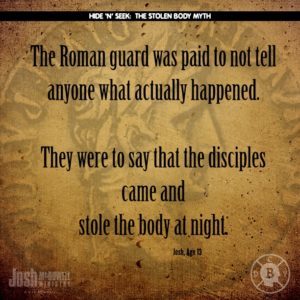
This Myth is about how Jesus “disappeared” from the tomb.
The Roman guard was paid to not tell anyone what actually happened. They were to say that the disciples came and stole the body at night (Matthew 28:12-15).
If they were to say that then, whoever they were telling that person should ask, “ Why were the guards not awake?”
If I was there when Jesus body apparently “disappeared,” then I would have asked the Roman soldiers, “didn’t you seal the tomb?” Also, I would ask “didn’t the stone weigh 2 tons?”
Another thing that the book points out is that the Roman soldiers would have heard the movement of the huge stone. The book also points out that the Roman guards were well trained and also heavily armed and had good armor, so I don’t know how a force that was trained and armed couldn’t win verses people who were not trained and just wanted to see that Jesus would raise from the dead.
The myth also says that the Roman guards who were awake would have been overpowered by the disciples. Sure one of them could; but can’t people hear when others fight?
In the book, Simon Greenleaf, said that “It is impossible for that to happen.”
In the end, Jesus body wasn’t taken–He rose from the dead, and we give thanks on Easter.
Josh, age 13
 The “Stolen Body Myth” is a myth, that says the disciples on the eve of Easter went and stole the body of Jesus and hid it–Hide ‘N’ Seek.
The “Stolen Body Myth” is a myth, that says the disciples on the eve of Easter went and stole the body of Jesus and hid it–Hide ‘N’ Seek.
This myth can be debunked by many Scriptures. 1 Corinthians 15 :1-8 says, that He appeared before Cephas and then to the twelve and then to 500 brothers. It also tells how He rose on the third day and that before that He was buried.
Also the disciples were locked in a room because they were so scared of the Pharisees.
They all, except John, died a martyr’s death. Why would a person die for something that is not real? I wouldn’t die for a fake religion and I don’t even think I could die for a real religion, much less a fake one.
The “Stolen Body Myth” can be debunked by the fact that they would never die for a lie or a myth.
Jonathan, age 12
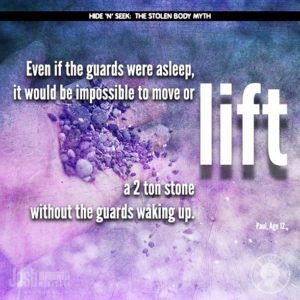
The tomb of Jesus was protected by at least 4 guards of the emperor, in front of a two ton circular stone, but the body of Jesus still got stolen… this is truly a one-of-a-kind resurrection myth.
Even if the guards were asleep, it would be impossible to move or lift a 2 ton stone without the guards waking up.
The guards were equipped with a 6 feet Roman pike on their right hand, a shield on their left hand, and a dagger on their left side. The disciples would not try to steal the body of Jesus while fearing being slain by one of these Roman guards.
Even if they stole the body of Jesus, they would never preach across the world knowing everything they are teaching is a lie, and would not die for this lie they made up.
If they knew it was a lie, 11 of the 12 disciples wouldn’t have died for a lie they made.
Paul, age 12
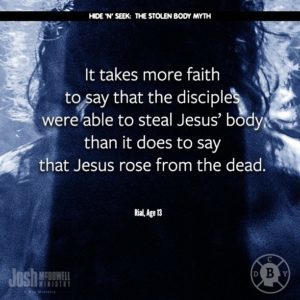
The stolen body myth says that Christ was taken from the tomb by the disciples so that they could say he had risen. This is not possible and is a myth.
It would have been impossible for the disciples to move the stone without the guards hearing. The stone was tall and weighed about two tons.
If the guards would have seen them they would have easily killed the disciples. The guards wore iron helmets and were armed with a Roman pike, a sharp iron head fixed in a shaft. They also held a shield and a sword.
It takes more faith to say that the disciples were able to steal Jesus’ body than it does to say that Jesus rose from the dead.
There is no other logical explanation to Jesus’ missing body.
Rial, age 13
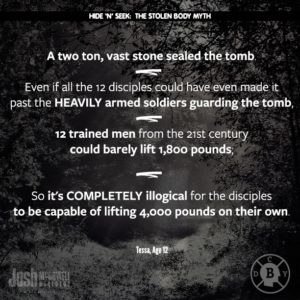
Just as mentioned in the 17th chapter, the “stolen body myth” was established in the Bible itself. The Bible says a soldier was sent by a chief priest to spread word the disciples had stolen the lifeless body from the tomb.
Even the most illogical human could identify this statement as highly flawed.
The two ton vast stone that sealed the tomb, is where I’m focusing in on. Factually, the average trained male can lift about 155 lbs. That is for a modernly trained middle aged male. The disciples, for one, where ranged in many different ages, and were also not modern age trained lifters. Two tons is about 4000 pounds.
Even if all the 12 disciples could have even made it past the HEAVILY armed soldiers guarding the tomb, 12 trained men from the 21st century could barely lift 1,800 pounds, so it’s COMPLETELY illogical for the disciples to be capable of lifting 4,000 pounds on their own.
As well, some argue that the disciples could have done it because they had God on their side and God could do anything, but if God could do anything than why can’t he raise Jesus from the dead?
It’s also quite difficult, at least I believe, to get past 16 highly trained, armed, and tough soldiers. I’d say, nearly impossible. These men carried 6 foot long javelins, a sword, and a dagger. Along with these items were also shields, supported by a strap around the shoulder. I’m pretty sure these soldiers had to be extremely strong to be able to fight, or battle with pounds of metal weighing them down, so they were most likely lively and brutal men.
On top of it all, if these soldiers were to fail at guarding the tomb they would be put to death, all of them. I know that’s NOT a risk I’d be even remotely willing to take, if I were a soldier.
So, in conclusion, I couldn’t imagine anyone’s logic and persuasion behind the “stolen body myth” because it is just so ridiculously obvious what the true story was using just common logic.
Tessa, age 12
“Today the sincere seeker of truth can have complete confidence, as did the first Christians, that the Christian faith is based not on myth or legend but on the solid historical fact of the empty tomb and the risen Christ.”
(Don’t Check Your Brains at the Door, p. 78)
Know what you believe…and why you believe it.
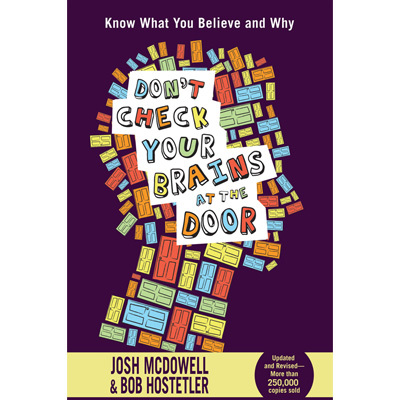
Don’t Check Your Brains at the Door gives teens answers that make sense, even for the toughest of questions:
Does it really matter what you believe, as long as you have faith?
Are there errors in the Bible?
Was Jesus just a good teacher?
Can anyone prove His resurrection?
What does that have to do with me?
Using clarity and humor Josh McDowell and co-author Bob Hostetler expose common myths about God, the Bible, religion, and life to show how Christianity stands up to the test of fact and reason.
With these solid evidences teens will be better understand the faith they live and know what they believe and why.
VIEW DON’T CHECK YOUR BRAINS AT THE DOOR IN OUR ONLINE STORE.
The post Student Blogs on “Hide ‘n’ Seek” appeared first on Josh.org.
July 17, 2018
Did Moses Author the Pentateuch?
 The Pentateuch, the first five books of the Old Testament, is a core text for three world religions and the foundation of the Christian Bible and the Jewish Scriptures.
The Pentateuch, the first five books of the Old Testament, is a core text for three world religions and the foundation of the Christian Bible and the Jewish Scriptures.So it matters that the texts be viewed with authority. It is through these books, long believed to have been revealed by God and recorded by Moses, that we learn the origins of humanity, as well as man’s purpose and destiny. Genesis, Exodus, Leviticus, Numbers, and Deuteronomy give us an overview of God’s plan of redemption. And these five historical books provide thr foundation for everything else that follows in Scripture.
Though modern skeptics challenge that Moses wrote the books (some even doubt he existed), there is plenty of evidence throughout the Bible, as well as external texts, to give us confidence that he did. Old Testament and New Testament references clearly and consistently testify to Mosaic authorship, authority, and influence.
~ Moses a Reliable Source? ~
The books certainly do not herald Moses‘ future as prophet, priest, and leader. Rather, the picture we are given is Moses as an anti-hero — a murderer and outlaw who, as he spoke with God at the burning bush, requested THIRTEEN times that God find someone else to lead the Israelites to freedom!
Who would invent such a hero as the founder of a nation? God — who always knows what He’s doing when he picks a person to achieve His plans.
Moses quickly grew into a strong, yet humble leader who kept the spotlight on God. As both an Israelite and former member of Pharaoh’s household, Moses had an insider’s knowledge and understanding of the Egyptian court. This was but one tool God gave Moses for his interactions with Pharaoh. Imagine that ultimate showdown: one man who believed he was a god (Pharaoh) being shown by God that He, alone, holds the title.
~ Biblical Evidence for Moses’ Authorship ~
Technically, the Pentateuch, also known in Hebrew as the Torah, is anonymous. But it specifically records God commanding Moses to preserve received revelation. There are both Old and New Testament references to Moses that validate that Moses did write them. Even Jesus and His disciples acknowledged a significant connection between Moses and the Torah, and Jesus frequently referred to these books as being Moses’ teachings.
Examples of the Old Testament references to Moses:
Exodus 17:14: Then the Lord said to Moses, “Write this as a memorial in a book and recite it in the ears of Joshua, that I will utterly blot out the memory of Amalek from under heaven.”
Exodus 24:4: And Moses wrote down all the words of the Lord.
Exodus 34:27: And the Lord said to Moses, “Write these words, for in accordance wit these words I have made a covenant with you and with Israel.”
Numbers 33:2: Moses wrote down their starting places, stage by stage, by command of the Lord, and these are their stages according to their starting places.
Deuteronomy 31:24-26: When Moses had finished writing the words of this law in a book to the very end, Moses commanded the Levites who carried the ark of the covenant of the Lord, “Take this Book of the Law and put it by the side of the ark of the covenant of the Lord your God, that it may be there for a witness against you.”
Examples of testimony to Moses’ role in lawgiving woven throughout the Old Testament:
Joshua 1:7,8 and 23:6: “Only be strong and very courageous, being careful to do according to all the law that Moses my servant commanded you. This Book of the Law shall not depart from your mouth, but you shall meditate on it day and night, so that you may be careful to do all that is written in it.”
1 Kings 2:3: (King David, on his deathbed, giving final instructions to his son, Solomon): “Keep the charge of the Lord your God, walking in His ways and keeping His statutes, His commandments, His rules, and His testimonies, as it is written in the Law of Moses, that you may prosper in all that you do and wherever you turn.”
2 Chronicles 17:9: “And they taught in Judah, having the Book of the Law of the Lord with them. They went about through all the cities of Judah and taught among the people.”
2 Chronicles 23:18: “And Jehoiada posted watchmen for the house of the Lord under the direction of the Levitical priests and the Levites whom David has organized to be in charge of the house of the Lord, to offer burnt offerings to the Lord, as it is written in the Law of Moses, with rejoicing and with singing, according to the order of David.”
Daniel 9:11,13: “All Israel has transgressed your law and turned aside…And the curse and oath that are written in the Law of Moses the servant of God have been poured out upon us, because we have sinned against Him. … As it is written in the Law of Moses, all this calamity has come upon us.”
Malachi 4:4: “Remember the law of my servant Moses, the statutes and rules that I commanded Him at Horeb for all Israel.”
Examples of New Testament References to the Law of Moses:
The New Testament also speaks of Moses’ significant involvement in the Pentateuch’s composition. Jesus often quoted Scripture traditionally attributed to Moses. In John 5:46, Jesus states, “For if you believed Moses, you would believe Me; for he wrote of Me.” And in Mark 12:26, Jesus says, “And as for the dead being raised, have you not read in the book of Moses, in the passages about the bush, how God spoke to him, saying, ‘I am the God of Abraham, and the God of Isaac, and the God of Jacob’?” After His resurrection, Jesus gave additional authority to these books when He taught the two who walked with Him to Emmaus how the writings pointed to and were fulfilled in Him.
The disciple Peter spoke of Moses’ Authority in Acts 3:22: Moses said, “The Lord God will raise up for you a prophet like me from your brothers. You shall listen to him in whatever he tells you.”
James spoke of Moses’ influence in Acts 15:21: “For from ancient generations Moses has had in every city those who proclaim him, for he is read every Sabbath in the synagogues.”
The Sadducees also spoke of Moses’ Authorship in Mark 12:19: “Teacher, Moses wrote for us that if a man’s brother dies and leaves a wife, but leaves no child, the man must take the widow and raise up offspring for his brother.”
Granted, none of this proves Moses was involved in writing the Pentateuch. But simply put, creation, human history, and the patriarchal period cannot be properly understood if not viewed in the life and work of Moses. Much of the Pentateuch, in fact, reads as Moses’ biography or perhaps autobiography.
~ Trusting the Reliability of the Bible ~
Until the 18th century AD, Moses’ authorship of the Pentateuch was largely unchallenged. But that’s not to say that anomalies did not go unnoticed. For example, could Moses have described his own death in Deuteronomy 34? While it’s possible that Moses received and recorded this by prophesy prior to his death, most scholars view this information to be an addendum by a later editor.
Moses may or may not be the single author of the Pentateuch. But he is decidedly the authority from which the Pentateuch emanated. The meaning, theology, and even history portrayed adequately reflect what Moses did say, pray, or sing. There is no reason to doubt Moses’ authorship of the oral tradition or some of the written records. But it is both possible and expected that revisions and updating occurred throughout its history right up until completion of the final version.
Still, some modern skeptics simply refuse to accept Moses’ role in the Pentateuch, due to lack of definitive evidence. Many have put forth numerous alternate theories about authorship that are quite convoluted. We have to remember that skeptics come with biases. Some deny the validity of the Old Testament. Others discount the supernatural accounts of God’s interventions reported in the Bible. Others bring personal beliefs to their interpretations. It is understandable that these factors shape how each scholar views and interprets the text.
But as the Skeptics Dictionary notes: “We know from experience that more often than not the theory that requires more complicated machinations is wrong.” In other words, the simpler the theory is, the more likely it is to be correct.
The model that remains the simplest explanation for the Pentateuch’s composition is the traditional Jewish and Christian model: Moses as the original author used some sources, and later editor(s) updated the text to ensure it was understandable to contemporary readers. Given the Bible’s track record of accuracy and reliability, should it not get the benefit of the doubt?
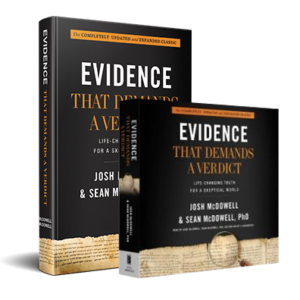
This blog post highlights Josh and Sean McDowell’s recently revised apologetics classic, Evidence That Demands a Verdict. We are certain this fully updated and expanded resource will be an effective evangelism tool for you, and strengthen your faith by answering the toughest questions tossed to you by skeptics. Know what you know, because it’s true. But share this truth with LOVE!
If you’d like to start from the first blog post in this series, click here: Apologetics: Apologizing for Believing in God?.
The post Did Moses Author the Pentateuch? appeared first on Josh.org.
July 14, 2018
There’s no God? How boring!

Original post by Sean McDowell here. Used with permission.
There’s No God? How Boring!
SeanMcDowell.org
Recently I showed my high school students the movie Expelled by Ben Stein, where he claims that intelligent design proponents have lost jobs, lost tenure and had their reputations smeared.
One of the memorable scenes of the movie featured William Provine, Cornell University Professor and outspoken atheist, articulating the implications of Darwinism. If Darwinism is true, says Provine, then there is no God, life after death, purpose, objective morality, or free will. According to Provine, they are all illusions fostered on us by our genes and environment.
Provine also criticizes intelligent design for being boring: “Can you imagine anything more boring? The boredom attached to ID is supreme. It is so boring that I can’t even be bothered to think about it for a second. It’s just utterly boring.”
He said this with utter contempt for the claims of intelligent design and for the implications that there may be a God.
The more I think about this quote the more I am convinced that Provine has it exactly backwards.
Intelligent design is not boring, atheism is!
I’m not saying that atheists are boring, for that would be an ad hominem fallacy. I have many atheist friends who are incredibly interesting people. In fact, some are far more thoughtful and engaging than many of my Christian friends. I am not criticizing atheists, but atheism. Atheists are often interesting people, not because of their philosophy, but in spite of it.
So why is atheism boring?
One problem with atheism is that humans are purely physical machines lacking free will (as Provine so clearly articulated). Thus, people are simply cogs in the materialistic universe dragged along by physical, social, and biological forces. Humans are simply puppets of nature acted upon by external forces in the environment rather than free beings that make meaningful decisions.
If naturalism is true and there is no free will, then there can be no real character development in life or in drama since people are helpless victims of their environment.
This is why film professor John Caughie says that naturalism is boring when applied to movies (Television Drama: Realism, Modernism, and British Culture, p. 96-97).
Why do we enjoy movies?
The simple answer is that we are drawn to characters that choose good over evil, hope over despair, and forgiveness over revenge. Yet if atheism is true, characters are driven entirely by the inexorable physical laws of nature—they don’t make any choices at all.
Thus, Luke didn’t really choose to battle Darth Vader and the Dark Side—his genes did it for him. Rocky didn’t really go against the odds to be the Heavyweight Champion of the World—the laws of physics did it for him. How boring!
An example of naturalism in drama is Anton Chekhov’s The Three Sisters. The primary desire of the three sisters is to escape small-town life and move to Moscow. The entirety of the play involves them talking about moving but never actually doing it. They simply cannot escape from social expectations and family customs. What a great depiction of naturalism. Naturalistic films provide no dramatic escape from the environment because people are trapped behind their environment.
These kinds of plays or films are frustrating, depressing, and anti-climactic. And yet they portray naturalism accurately. Again, how boring!
Ultimately, the deterministic worldview of atheism fails to capture life as we truly experience it. In her excellent book Saving Leonardo, Nancy Pearcey sums up the problem determinism poses for film:
“A deterministic worldview produces characters that are not true to life. In reality, people do make genuine decisions. Much of the drama of human life stems from wrestling with wrenching moral dilemmas. Though naturalism was an offshoot of realism, we could say its greatest flaw was that is was not realistic enough. We all experience the moment-by-moment reality of making choices. The experience of freedom is attested to in every human culture, in every era of history, and in every part of the globe” (p. 152).
A test for every worldview is if it can describe the world as we actually experience it. If a worldview fails to explain a universal human experience (such as free will) then it is inadequate.
Professor Provine may choose to deny the existence of free will, but since he is made in the image of God, his life will betray that conviction.
In Expelled he tells his story of rejecting Christianity because of the compelling evidence for Darwinism. Ironically, one of the reasons he tells this is because he’s trying to persuade people to follow the same course. Yet if people are determined then they can’t choose otherwise. In fact, people can’t choose anything! Provine didn’t really even choose to reject Christianity—his genes did it for him. As sincere as Provine may be, I doubt he really believes this.
Again, my critique is aimed not at atheists but at atheism. Provine strikes me as an eminently interesting person that I would enjoy getting to know.
Nevertheless, I just can’t think about it any longer. It’s simply too boring.
Sean McDowell, Ph.D. is a professor of Christian Apologetics at Biola University, best-selling author, popular speaker, part-time high school teacher, and the Resident Scholar for Summit Ministries, California. Follow him on Twitter: @sean_mcdowell and his blog: seanmcdowell.org.
The post There’s no God? How boring! appeared first on Josh.org.
July 13, 2018
Student Blogs on “Blind Man’s Bluff”
Blind Man’s Bluff: The Wrong Tomb Myth
The Resurrection of Jesus is the central point of the Christian faith. Those who do not believe in Christ often argue that the resurrection never happened. What if the women on Easter Sunday found the tomb empty, only because they stumbled on the wrong tomb?
Even if Jesus’ tomb hadn’t been surrounded by a Roman guard, would they really have forgotten the location so soon after they saw Him buried?
Joseph took the body, wrapped it in a clean linen cloth, and placed it in his own new tomb that he had cut out of the rock.
He rolled a big stone in front of the entrance to the tomb and went away.
Mary Magdalene and the other Mary were sitting there opposite the tomb.
…
After the Sabbath, at dawn on the first day of the week, Mary Magdalene and the other Mary went to look at the tomb.
Matthew 27:59-61, 28:1
Study Sessions
Read Matthew 27:57-28:15.
What individuals or groups of people would have know the correct location of the tomb?

Many people will tell you that Jesus never really rose from the dead, the women simply went to the wrong tomb. However, this cannot be true.
When the women left to see the tomb on Sunday morning, it was not their first time. They were there two nights before. Don’t you think one of them would have noticed?
If they went to the wrong tomb, then do you think just any tomb would have angels around it?
Let’s suppose that the women did go to the wrong tomb. After they were there, they rushed to the disciples and they took Peter and John to the tomb. If they saw Jesus buried like described Matthew, don’t you think they could tell if it was the wrong tomb?
The tomb was also sealed by a Roman seal. Not every tomb has one of those. Even if they all went to some other tomb, then couldn’t the chief priests and the Romans go to the tomb, and show them they were wrong?
You see, Jesus’s tomb was well distinguished so nobody could be so careless as to mistake His for another.
Mitchell, age 12

Many people believed and some still believe today that the women who had reported the missing body in the tomb actually went to the wrong tomb, but that’s a myth.
They absolutely went to the right tomb and to think they went to the wrong one is just crazy.
Matthew 27:57-28:15 is filled with verses that list the many people who had known for a fact that they knew the exact and correct location of the tomb.
Also, in Matthew, Mark and Luke they all have recorded information about specifically the women who saw Jesus’ burial and who clearly would have known where the location of his tomb was.
In this chapter of Don’t Check Your Brains at the Door, it says that a girl, Elizabeth, questions Mary, her friend, about actually seeing the empty tomb. She questions her about the fact that it was empty and says maybe you just went to the wrong tomb, but Mary makes it very clear to her that she knows what tomb she went to and that it wasn’t the wrong one.
Izzy, age 13
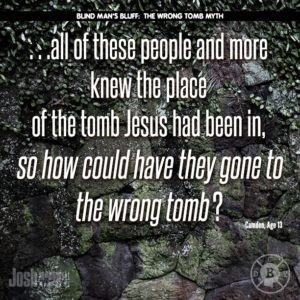
In the Wrong Tomb Myth, people believe the women went to the wrong tomb because there was no body in that location.
They are correct about the fact that there was no physical body still in the tomb but incorrect about it being the wrong place.
The women were in the right place, but they couldn’t comprehend that Jesus died and rose again. That is exactly why He “wasn’t there.”
There were actually many people who knew the correct location of the tomb including Joseph of Arimathea, Mary Magdalene, the other Mary, the Roman guard, the angels, etc.
While at the empty tomb, the angels told those there not to be afraid because Jesus had risen from the dead just as He had said.
All of these people and more knew the place of the tomb Jesus had been in, so how could have they gone to the wrong tomb if many had known the very place he had been set to rest?
Camden, age 13

In chapter 16 we learn about The Wrong Tomb Myth. The wrong Tomb myth is pretty self explanatory in its title but this myth is about all the myths people have brought up saying that Jesus never really resurrected he just was put in the wrong tomb.
Obviously as Followers of Christ we know for a fact the he died AND resurrected for our sins, but some people think otherwise.
If Jesus was put into the wrong tomb then our sins would have not been paid for which would be a problem.
On Jesus burial day they put him in a tomb and sealed it shut with a big rock.
They also put guards out there to watch the tomb so no one would steal his body and say he resurrected, so the guards would have known where his tomb was and knew that he didn’t get put in the wrong tomb.
Another example would be that Jesus was wrapped in fine white linens and when they opened up his tomb they saw that the linens were neatly folded and that he in fact had resurrected.
Even though not everybody believes this, we do and what matters is that we help the people who don’t believe and continue to thank God for all he has done.
Madyson, age 12

The wrong tomb myth states that maybe when they saw the empty tomb Jesus once laid dead was actually not his. This is wrong.
There was a number of over 9 people who knew where Jesus’s tomb was. And the priests were gonna make sure that they ordered guards to stand in front of the right tomb.
Jesus was the man who claimed to be the Messiah. It is so slim a chance that they would lose the Son of God.
But even if they had the angel that God sent down to the tomb would not have gotten lost!
So no matter how hard you try, you can only come to one conclusion.. Jesus’s tomb was really empty on that Easter Sunday.
Birdie, age 12
“Today the sincere seeker of truth can have complete confidence, as did the first Christians, that the Christian faith is based not on myth or legend but on the solid historical fact of the empty tomb and the risen Christ.”
(Don’t Check Your Brains at the Door, p. 78)
Know what you believe…and why you believe it.

Don’t Check Your Brains at the Door gives teens answers that make sense, even for the toughest of questions:
Does it really matter what you believe, as long as you have faith?
Are there errors in the Bible?
Was Jesus just a good teacher?
Can anyone prove His resurrection?
What does that have to do with me?
Using clarity and humor Josh McDowell and co-author Bob Hostetler expose common myths about God, the Bible, religion, and life to show how Christianity stands up to the test of fact and reason.
With these solid evidences teens will be better understand the faith they live and know what they believe and why.
VIEW DON’T CHECK YOUR BRAINS AT THE DOOR IN OUR ONLINE STORE.
The post Student Blogs on “Blind Man’s Bluff” appeared first on Josh.org.
July 12, 2018
Was the Bible Exodus a Real Event?
 Did the Israelites Flee Egypt for the Promised Land?
Did the Israelites Flee Egypt for the Promised Land?In our last blog post we looked at whether there is definitive proof that Adam and Eve existed as real people. In this blog post we’ll look at what proof exists for the mass Exodus of the Israelites from Egypt.
No doubt about it, the Exodus of the Israelites, an event the Bible describes in great detail, is one of the most important historical events for both the Jewish and Christian faiths. Why? Because this central experience of rescue for the helpless out of a desperate condition has been recognized as a key example of God’s love.
Too, it is an example of God asserting His supremacy. In each plague He sends, God repeats this message: “I alone am God.” And in each miracle He provides for the Israelites as they flee Pharaoh’s pursuit, God reminds them that “I am who I am!“
The Bible tells us that Pharaoh — considered a god — was just a man that God specifically placed on the throne for the big showdown with Moses. God, alone, can claim the title. Before He orchestrated the Israelite’s exit from Egypt, God brought 10 plagues that crushed the legitimacy of the numerous deities of the Egyptian people.
Let’s look at the Exodus details, and then at existing evidence for the event. Its symbolism alone makes the Exodus story invaluable.
~ The Exodus Story ~
It is in Exodus 3:7-8 that we see God speak after He decides to take action:
“I have surely seen the affliction of My people who are in Egypt, and have heard their cry because of their taskmasters, for I know their sorrows. So I have come down to deliver them out of the hand of the Egyptians, and to bring them up from that land to a good and large land, to a land flowing with milk and honey.”
So God sends the 10 plagues, which the Egyptians dismiss until the pain finally cuts too close to the bone. Gnats didn’t move them. Flies didn’t move them. Neither did thick darkness. Not even the decimation of Egyptian crops and cattle motivated Pharaoh to agree to God’s demand to “Let my people go!” (Charlton Heston, time for your cameo!) #Moses
Only at the last plague — in which every Egyptian firstborn dies — do the now shellshocked Egyptians finally beg the Israelites to get the heck out of Dodge. They even dump parting gifts of silver, gold, and clothing on the Israelites! (And we know what the Israelites did with that gold, right?) #calfidol
An interesting GotQuestions.org article sheds light on why God may have cherry-picked each plague. Examples: The second plague, of frogs from the Nile, was a judgment against Heqet, the frog-headed goddess of birth. Egyptians viewed frogs as sacred, and not to be killed. Yet God used the frogs to make a stench in the nostrils of the Egyptians, as they piled the dead, rotting frogs into heaps across the land (Exodus 8:13–14). The ninth plague, of thick darkness, was aimed at blasting the sun god, Ra, symbolized by Pharaoh himself. For three days, the land of Egypt was “smothered with an unearthly darkness, but the homes of the Israelites had light.” The tenth plague, the death of all firstborn males, was a smackdown on Isis, the supposed protector of children.
Finally, Pharaoh changed his tune from, “Who is the Lord, that I should obey his voice and let Israel go? I do not know the Lord, and moreover, I will not let Israel go!” to something like, “Crap! Leave! Now!”
It seems incredulous that almost immediately, however, he decides that freeing the Israelites was a really dumb move. Mighty Egypt depended on their manpower. So Pharaoh orders his army to open the throttles on their chariots and make haste to reclaim their slave labor. (Okay, I will cut him some slack; Pharaohs were quite used to getting their way and calling the shots.)
But I wonder if God yawned at the little effort it took Him to stall their progress as He used high winds to separate the Red Sea so the Israelites could walk (bug-eyed, no doubt!) between the watery walls. Only when the huge crowd had reached the waiting shore did God allow the Egyptian army to proceed — and then drowned them as He snapped the divided walls closed. (Even with really bad overacting by Heston and the rest of the Ten Commandments movie cast, the scene is impressive.)
The obvious symbolism: in the Old Testament we see God use Moses to lead the Israelites out of physical slavery. In the New Testament, we see God use His son to free the entire human race from spiritual slavery.
~ Archaeological Limits ~
Jews and Christians have, for centuries, embraced the Exodus story. Because the Bible has proven itself trustworthy as a book of truth and fact.
Only in the last 20 years or so have scholars decided the event isn’t historical, due to lack of evidence. But, says scholar Anthony Frendo:
“Israel must have somehow (at least partially) come from outside Canaan in view of the multiple texts in the Old Testament which point in this direction. Why should the Old Testament authors have made this up? Should we not try harder to understand our texts in connection with the results of good archaeology, rather than superficially to dismiss the former?”
It is true that outside of the Bible, there isn’t much evidence for the event. But that shouldn’t surprise us, asserts Alan Millard of the University of Liverpool, for several important reasons:
“Lacking any trace of Joseph, Moses, or Israelites in Egypt, many have concluded they were never there. Yet no pharaoh would boast of the loss of his labor force on a monument, and administrative records on papyrus, leather, or wooden tablets which might have registered such events would perish rapidly in the Delta’s damp soil. It is equally unlikely that a camping crowd would leave recognizable remains from a semi-nomadic life in the Sinai Wilderness and in Transjordan. The absence of evidence is not, therefore, evidence of absence!”
Old Testament scholar and Egyptologist James Hoffmeier confirms that Goshen, in the Nile Delta, is quite moist due to rain and annual flooding. If the Israelites had been in the dry Southern region, where the Dead Sea scrolls have been uncovered, he is certain papyrus documents would have survived. “We have to be realistic,” he adds, “about what we think archaeology can and can’t do.”
“Archaeological discoveries have verified that parts of the Biblical Exodus are historically accurate, but archaeology can’t tell us everything, agrees the Biblical Archaeological Society. “Although archaeology can illuminate aspects of the past and bring parts of history to life, it has its limits.”
Our key takeaway: limited evidence does not mean the event didn’t happen as the Bible tells it.
~ Proof for the Plagues, Then? ~
Again, hard to prove. But some scholars give credence to naturalistic phenomenon, which God certainly could have used to achieve His goal. Hoffmeier explains:
“Some have theorized that the first plague — in which the Nile turns blood red — is associated with the presence of microscopic flagellates in the water that account for the color. This phenomenon is associated with the annual inundation of the Nile that begins in August, crests in September, and ends in October. These microbes consume large amounts of oxygen from the water which results in fish dying and causes a rank smell, rendering the water undrinkable as described in the Bible (Exodus 7:21). If indeed a contaminated annual flood marked the beginning of the plagues, which would have begun in the period of August to October, and since Passover is observed in the period March-April (that is, seven to nine months later), the ninth plague — three days of darkness — might have been caused by a severe dust storm or khamsin. Such dust storms can still blanket Egypt for days at a time during the months of March and April. They even darken the sun and fine dust covers everything. This scenario for the ninth plague certainly fits the description that it was a darkness to be felt (Exodus 10:21). By using the forces of nature against Egypt, the God of Israel demonstrated His superiority over the gods of Egypt and over Pharaoh, who was responsible for maintaining cosmic order in the land.”
How often, I wonder, does God use “the forces of nature” to make His point? But like the Egyptians, we often refuse to acknowledge the Hand of God until the pain becomes excruciatingly personal. Only then do we move.
~ Taking the Bible as Truth ~
We find the Exodus mentioned as a historical event throughout the Old Testament, including the books of Psalms, Joshua, Judges, 1-2 Samuel, 1-2 Kings, and in the Prophets. We should note that the Bible is not a single source document. It is multiple sources, all of which maintain the authenticity of the Exodus tradition. Historians recognize that the likelihood of the authenticity of an event increases as independent sources that verify it are discovered.
To date, scholars cannot concretely prove that Moses existed, that Israel lived in Egypt, or that this group of Hebrews fled from Pharaoh. But neither can they disprove the historicity of the biblical narrative.
As Hoffmeier notes:
“With this overwhelming evidence within the Bible regarding the Egyptian sojourn, exodus, and wilderness episodes, evidence coming from a variety of types of literature and used in a host of different ways, it is methodologically inadvisable, at best, to treat the Bible as a single witness to history, requiring corroboration before the Egypt-Sinai reports can be taken as authentic.”
Simply put, there is enough evidence contained in the Bible to make the story believable. It is likely such a man as Moses existed, a people such as Israel lived in Egypt, and these people left Egypt via the route detailed in the Bible.
“Many people today treat the Bible as being guilty until proven innocent,” adds Hoffmeier. “Which doesn’t seem fair, as who’s around to prove it that lived back then?”
I stand firmly in the camp that God can do what He says He’s going to do, whether large or small. When I read of the Bible’s miracles — from the miraculous parting of the Red Sea to the miraculous resurrection of Jesus — it’s not my default to think, “I’m not believing it until I see definitive proof!” Rather, my default is, “Wow! Mind blown!”
I want my God, as we say here in Texas, “to go big, or go home!”

This blog post highlights Josh and Sean McDowell’s recently revised apologetics classic, Evidence That Demands a Verdict. We are certain this fully updated and expanded resource will be an effective evangelism tool for you, and strengthen your faith by answering the toughest questions tossed to you by skeptics. Know what you know, because it’s true. But share this truth with LOVE!
If you’d like to start from the first blog post in this series, click here: Apologetics: Apologizing for Believing in God?.
The post Was the Bible Exodus a Real Event? appeared first on Josh.org.
Josh McDowell's Blog
- Josh McDowell's profile
- 644 followers



